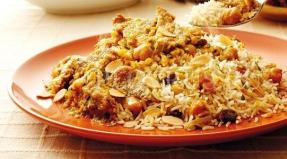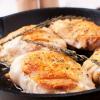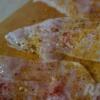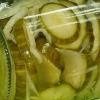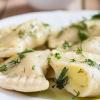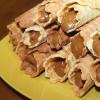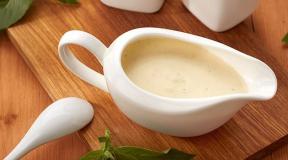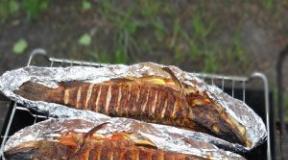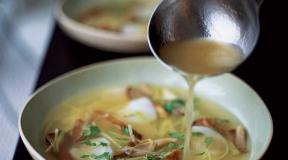Pilaf with chickpeas - step-by-step recipes with photos. Pilaf with chickpeas: recipe
Do you want to surprise your friends? Prepare them Uzbek pilaf in Samarkand style. What's so surprising about it, you ask? This type of Uzbek dish is unusual in that, firstly, it does not have a pronounced yellow or even brownish tint, which everyone is accustomed to seeing in Fergana pilaf (namely, Fergana pilaf is usually served in all Uzbek catering points from Moscow to the outskirts). The rice in this dish remains almost white. Secondly, it is prepared not only with lamb, but also with lamb peas - this is the name of a legume family plant popular among Uzbeks. The taste is specific, unusual, worth a try. That’s why today we have pilaf with chickpeas - we give the recipe and some useful tips. 
Recipes for pilaf with chickpeas
How is pilaf with chickpeas prepared? Why is he interesting?
Firstly, it is worth noting the cooking method. It is different from the usual and requires some skill and dexterity. Because ordinary Uzbek is cooked with all components cooked to maximum, and this gives an intense color and unique taste to the dish. 
Secondly, the usual version is cooked in a zirvak, all the rice is evenly saturated with this thick sauce, to the very top. The first commandment of someone who knows how to cook Fergana-style pilaf is not to stir everything that is in the cauldron until the very end of cooking. 
But Samarkand pilaf with chickpeas completely refutes these theories, because it has its own cooking characteristics:
- The rice is not completely filled with water, only the lower part, while the upper layers are steamed. And in order for heating and cooking to be uniform, you must periodically turn over, “shovel” the rice, swapping layers, collecting the rice in a heap and making indentations in the grain to allow steam to escape. This is the trick and complexity of preparing this dish;

- meat is the second feature of the dish. It's coarsely chopped here. Large pieces are served to everyone along with a small cutting board and knife, so that everyone can cut as they like;
- rice - if dev-zira rice is usually used for Fergana, then Samarkand is often prepared from Khorezm rice, for example, it can be the Lazar variety;

- carrots should be yellow. However, yellow carrots, which are cheaper in Uzbekistan and more aromatic than regular carrots, are also used in other types of pilaf. Samarkand residents simply use only one yellow one.

Chickpeas are good both as part of a meat dish with lamb, and as a component of a vegetarian dish. In the latter case, it is simply irreplaceable - it is a highly digestible vegetable protein that can replace meat protein. Which, you see, is good for fasting people and those who do not eat meat on principle. Below we will give a recipe with photos of both a meat dish and a vegetarian one.
Despite the unusual preparation, it is not at all difficult to cope with Samarkand pilaf and chickpeas.
Especially if there are recommendations with step-by-step photos. If you have lamb (you can take beef, pork, chicken, etc.), chickpeas, vegetable oil, onions and carrots, then we’ll tell you how to cook real pilaf from Samarkand at home. 
Uzbek pilaf with chickpeas
How much meat should I use for pilaf with lamb or beef and chickpeas? There are no exact requirements here. Usually Uzbeks do not hang food on scales - it’s all by inspiration and tradition. And the tradition for preparing this particular pilaf is this: there is little onion, a lot of carrots and meat, approximately equally, a little less rice than meat.
Uzbek pilaf with chickpeas has a pronounced taste and aroma of carrots and fried meat.
Therefore, the classic ratio of meat, carrots, rice and onions is: 1 kg - 1 kg - 800 g - 3 pcs. (one onion, whichever is smaller, will be discarded after frying). Plus another 150 grams of fat tail fat, 200 g of vegetable oil, cumin, barberry, 2-3 heads of garlic, whole pepper, salt. 
The real recipe for cooking a dish in a cauldron looks like this.


Wash thoroughly so that no flour remains and as much starch is removed from the rice as possible. This is the key to making your rice fluffy!
- Heat the oil in a large cauldron and fry the onion over high heat until dark.

The tradition of frying an onion refers mainly to cooking with cottonseed oil, which has a slight bitterness and a peculiar aroma.
Heating removes the bitterness, and the onion removes the specific smell.
We add onions only to add the desired aroma to the oil, and use clarified sunflower or olive oil for frying.
- Remove the onion and discard, melt the fat tail cut into small pieces. Remove the cracklings, but do not throw them away - then we will return them to the pilaf.
- In oil heated to maximum, put onion cut into half rings and immediately - large pieces of meat (cut the meat at the rate of one piece per serving).

- Fry quickly so that the meat acquires a confident, bright color. Here you definitely need to salt it!
- While we fry the meat, cut the carrots into large cubes. The meat is browned - put half a carrot, on top of it - chickpeas discarded from the water, hot pepper, and if you have it, then a handful of barberry. Yes, don't forget to put the cracklings back!
- Place the rest of the carrots on top of the chickpeas, sprinkle with a pinch of cumin, and add the whole garlic. There is a trick here - only the part of the carrot that is below will be covered with water. Everything else, including chickpeas, is steamed. Therefore, the secret is to pour hot water very carefully, just enough to cover the lower part of the carrots.

- Cover with a lid and reduce heat to medium. That's it, for about twenty minutes everything is prepared without your participation.
- Zirvak. and this is it, it’s ready, it’s time to put in the rice.
- We spread the rice evenly with a slotted spoon and fill it with the best water, heated to a boiling point. Salt the water well. You need to pour a little - so that half of the rice is in water and half is steamed.

- It is cooked over low heat, so that the rice is soaked with oil from below, and then, obeying the movement of your hands with a slotted spoon, it is turned over to steam completely and evenly. Turn it over two or three times, shovel it, each time making small outlet holes for steam.
- Now toss the rice a little on the spoon - does it fly apart? So everything is correct. It's time to cover with a lid and leave to finish.
- The pilaf is served like this: first add rice, then add chickpeas and carrots, and place a piece of meat on the side of the plate. The meal starts with rice to appreciate the chef's skill in preparing rice.

Vegetarian pilaf with chickpeas
The chickpeas in vegetarian pilaf will definitely not have time to cook and will be raw if they are not first soaked for a day. The water is changed three to four times.
For vegetarian pilaf, take half a kilo of rice (can be Krasnodar or regular long-grain), half a glass of chickpeas, two onions, 3 carrots, 250 g of vegetable oil, spices (barberry, cumin, garlic). Here is a step-by-step cooking recipe.
- Fry carrots and onions in heated oil.

- Add chickpeas and spices to the cauldron.

- Add rice soaked in salted water.

- Stick a head of garlic into the rice.

- Pour boiling water a couple of centimeters above the rice.

- Cook for 40 minutes until the rice is cooked and the water has boiled.

- Keep in a closed cauldron over low heat for a little longer and serve, stirring.

Pilaf with chickpeas in a slow cooker
When there is no cauldron or even a thick-walled duck pot of suitable size, a multicooker is used. Of course, you can’t expect pilaf identical to the real Uzbek one, but the result is a rather tasty and balanced dish.
Pilaf with chickpeas and various additives - raisins, you can add dried apricots, but more often they just add pepper and garlic.
To prepare pilaf, you will need half a kilo of meat (chicken, beef, lamb or pork), carrots, rice, three small onions and spices - cumin, hot pepper and a little ground black, as well as barberry, if available.
Secrets of perfect pilaf with chickpeas
If you want exactly the Samarkand taste, then you do not need to add any spices except pepper, barberry and cumin. It will turn out very tasty! And no ready-made combinations for pilaf, no bay leaves and our South Russian seasonings like dry dill!
Chickpeas differ in cooking time. It should either be allowed to swell in water or boiled in advance.
If you are preparing vegetarian pilaf, it does not take long to cook, so it is better to boil the chickpeas before putting them in the cauldron. The same goes for quick-cooking chicken. If you cook it with lamb or beef, it is better to soak it and put it raw in a zirvak. 
For chickpea pilaf, take the best rice - whole, clean, it is better to buy it at the Uzbek market, where chickpeas are also sold.
After cooking, let the pilaf “rest” a little, only then serve. 
Some useful information about chickpeas
How to soak chickpeas? After all, it depends on how the peas are soaked whether they will be soft and at the same time dense in the pilaf or whether they will turn out tough and undercooked. Then you certainly won’t be able to help the pilaf. 

For soaking, use water at room temperature. Usually, when preparing pilaf with peas, it is soaked overnight. In principle, fresh chickpeas will soak in 4 hours, but how can you find out how long they have been sitting, and therefore drying out? Therefore, put it on overnight - and it will be right.
Chickpeas are a legume plant prone to rapid fermentation. Therefore, do not be lazy to change the water more often when soaking, rinsing the cereal with fresh water.
There is another delicate point here: like all legumes, chickpeas can contribute to bloating. This trouble will not occur if you soak it well. You can add a little soda and then rinse.
And lastly: chickpeas are considered the best product among other legumes in terms of digestibility and healthfulness. And the most interesting in taste. It’s good that from eastern countries, chickpeas (that’s what chickpeas are also called) are gradually coming to the table of Europeans.

We all love pilaf. As a rule, the recipes are very similar to each other. Only some people use chicken rather than pork, others use lamb. Some housewives may add dried apricots and other dried fruits, but for the most part the recipes have already become very traditional. We suggest you take a new approach to preparing this dish and try pilaf with chickpeas.
Some useful information about chickpeas
Perhaps someone does not understand what we are talking about. Not everyone knows this product, which is very rarely used in our country for housewife cooking, which cannot be said about the countries of the East. And there, as you understand, they know a lot about food.
Chickpeas are peas that can be called Turkish or lamb peas. It belongs to legumes, which have long been valued for their nutritional value and great benefits for our health. You can often hear that beans can replace meat for a person and make him strong and healthy. So chickpeas were known for many centuries before our era. And then it was already used for food and for treatment.
Turkish peas contain a lot of useful minerals, vitamins and other substances. It contains fiber, proteins and fats that are valuable for our digestion, many amino acids, B vitamins, as well as A, C, E, P. Chickpeas have a beneficial effect on all organs, normalize digestion, improve heart function, cleanse the body of cholesterol, help liver and kidneys. Moreover, chickpeas are an excellent prevention of cancer and aging. It will also help with mental activity.
Chickpeas contain a minimal amount of calories - only 120 kcal. It is recommended by nutritionists; moreover, by cleansing the body of harmful substances, you can not only lose weight, but also become more attractive in appearance, since your skin and hair will have a natural healthy shine.
It would take a long time to list the benefits of the bean itself, as well as pilaf with chickpeas, but you already understand the main thing. Now it’s time to move on to recipes and secrets of preparing dishes from this healthy product.
Secrets of perfect pilaf with chickpeas
In order for the peas to be tasty, have time to cook, and at the same time the rice is not overcooked, you need to soak it in water in advance. This is usually done a day before the intended preparation of pilaf. If the chickpeas are of high quality and fresh, then they can be ready within 12 hours. The peas should be soaked in a large volume of cold water, which they will then partially absorb.
Important! To prevent the water along with the chickpeas from turning sour, it is better to change it several times a day or put the container in a cold room.
When your chickpeas have reached the desired stage, they are washed under running water and set aside, but it is better not to throw out the water that has turned yellow. It is very beneficial for the skin, can be used for washing, or better yet, pour it into an ice tray and wipe your face with these cubes every day.
It is better to take brown rice for pilaf; if you can find it, it is better to use alanga rice. The cereal should be round and whole. In some regions, chickpeas are combined with rice in a cauldron in different ways. The first thing is to place the peas in a heap in the center, and then cook the pilaf. The second way is to cook the chickpeas in advance and then add them to the cauldron with the vegetables. The third is to simply add the peas after soaking. If you don’t have a good cauldron, then take a pan with a thick bottom.
Carrots for pilaf are always cut into strips. It is not grated, as many housewives are used to doing. The longer the carrot sticks, the better. It is better to add spices in the main quantity not immediately and not at the end of cooking, but in the middle of cooking. So, it's time to get down to business.
Recipes for pilaf with chickpeas
Uzbek pilaf with chickpeas
As you already understood, the first thing you need to do is soak the peas for a day. Next you will need:
- lamb meat (you can take the thigh part) – 1 kg;
- carrots and rice - the same amount as meat of both;
- onions – 3-4 medium-sized pieces;
- garlic - take two pieces in medium-sized heads;
- chili pepper – 1 piece;
- spices – cumin and cilantro, one tablespoon each, peppercorns and red pepper powder, one teaspoon each;
- vegetable oil – 350 grams;
- salt – coarsely ground to taste;
- chickpeas - a glass.
We start cooking by peeling the vegetables, cutting the carrots into strips, peeling the garlic and onions, and cutting the first one into half rings. The meat is washed and cut into pieces. The cauldron is placed on the stove so that it warms up well over high heat. Then pour oil. When it starts to boil, add carrot sticks, after the vegetable has browned, take it out and put the lamb in the cauldron. When it has acquired a crust from frying, add onions.
The spices are put in a mortar and rubbed, after which they are poured into the oil, but not the entire volume, then the carrots are added. All this should simmer together for some time, then add soaked peas. You need to boil water in a kettle in advance and pour boiling water over the entire contents of the cauldron one centimeter above the surface. Add grated spices here. When the water starts to boil, reduce the heat. Peppercorns are added here. At this stage, zirvak is prepared, that is, this is the name given to the base of pilaf without rice.
Advice! Not everyone likes pepper in their food, but it adds a unique taste. Therefore, you can use an infuser for spices during cooking. Remove the pepper the moment the rice is added.
When the vegetables and meat have simmered for about half an hour, make a hole inside and add garlic and chili pepper, add salt to taste. Leave to simmer for another half hour, during which time the rice is cooked - washed several times, after which it is soaked for 15 minutes. When 30 minutes have passed since the pepper and garlic were added, remove the first peppercorn and lay out the rice. After which boiled water is poured here.
The recipe may be slightly different. For frying, you can use not sunflower oil, but cottonseed oil and fat tail fat. You can also put 2 teaspoons of raisins and barberries here and sugar on the tip. Chickpea pilaf and its recipes may vary slightly. For example, some people don’t like chili peppers, others don’t like fat. So you don't have to use them.
Advice! It is better to use a slotted spoon when adding water. Pour through until the rice is completely filled.
Now you need to increase the heat and wait until all the water has evaporated from the cauldron. Then make three holes in the rice and pour a little water into them, cover tightly with a lid and after half an hour of simmering over low heat, your pilaf is ready.
Vegetarian pilaf with chickpeas
If you eat meat, then this is not a reason to refuse delicious pilaf with chickpeas. Use this recipe:
- ½ cup of peas is soaked in water for a day, changing it 3-4 times;
- three carrots are peeled and cut into strips;
- two onions cut into half rings;
- pour 250 grams of sunflower oil or any other into a saucepan, but it’s better to pour into a cauldron;
- heat the oil and add onions and carrots;
- prepare spices in quantities - a tablespoon of barberry, a teaspoon of red pepper, cumin;
- spices and chickpeas are placed in the cauldron;
- Rice (it is better to take brown) is washed, soaked for 10 minutes, after which it is placed in a cauldron. You can also put soy meat here if you want;
- The rice is distributed and a head of peeled garlic is placed inside;
- boiled water is poured so that there is two centimeters above the surface;
- add salt to taste;
- cook the pilaf for 40-50 minutes until the water boils away. Then remove the cauldron from the stove, mix everything, remove the garlic.
Pilaf with chickpeas in a slow cooker
Chickpeas are soaked for 24 hours. After which it is cooked in a slow cooker. Next, pour a couple of tablespoons of oil here and add three onions previously cut into half rings and carrot strips (0.5-1 kg). Cut chicken fillet or other meat in the quantity needed. Add the meat to the slow cooker, pour in two tablespoons of tomato paste.
150-200 grams of rice are washed and soaked for 10 minutes. Then put the cereal in a bowl and place a head of garlic in the center. Add spices and salt to taste. It is better to take cumin, black and red pepper. You can also add raisins. Fill the entire contents with boiled water so that it is a couple of centimeters above the surface. All is ready. Now set the program for cooking pilaf or cook it yourself until all the liquid has boiled away. Afterwards, mix the contents.
Everyone loves pilaf with chickpeas. A step-by-step recipe is described in our article so that everyone can quickly and effortlessly prepare this magnificent dish, suitable for holidays and everyday life.
Pilaf recipe
Step No. 1 - preparing products
The entire process will take from 1 to 2 hours. To prepare delicious pilaf you will need a simple set of ingredients:
- lamb meat of the first freshness (you can take any part of the carcass, for example, a shoulder blade is suitable) - minimum 800 grams, maximum 1 kilogram;
- high-quality rice, round, steamed long, Basmati or Devzira varieties (any variety of rice that does not have the ability to steam is suitable) - minimum 600 grams, maximum 1 kilogram;
- chickpeas (another name is chickpeas) - 200 grams (at least half a glass);
- fresh carrots (yellow variety is welcome) - no less than 600 grams and no more than 1 kilogram;
- fresh onions - 150-350 grams (this is 2-3 onions);
- cumin spices (another name is cumin) - 1 teaspoon;
- garlic - 1 clove or 1 head, depending on taste preferences;
- salt - a couple of teaspoons.
Optional but useful additions for variety:
- chili pepper - 1 piece;
- tail fat (combined with hot oil for frying onions) - 100 grams;
- granulated sugar - half a teaspoon;
- cottonseed oil (or any neutral oil) - 200 milliliters;
- spices made specifically for pilaf - 2-3 teaspoons;
- dried fruits raisins - 2 large spoons;
- dry barberry - 2 small spoons;
- cumin - 1 teaspoon.
Step No. 2 - preparing the pilaf base
You will definitely be able to make a good pilaf with chickpeas. The step-by-step recipe continues processing the base ingredients. The chickpeas must first be soaked for 2 hours. The washed rice also needs to be soaked for half an hour. Separating the veins from the meat, rinse it and cut it as desired.
Step #3 - frying the onions
If you use fat tail fat, you must first melt it together with butter and then cook the onions in it. Traditionally, onions are cut into medium rings. You can use a frying pan, but a cauldron works best. Place onion in oil heated to a boil. The rings or half rings should take on a dehydrated appearance and a brownish-golden hue. The onions should not be overcooked.
Step #4 - processing the meat and adding carrots
Add cubed meat to the fully cooked onion. In this case, it is necessary to maintain intense heat for frying meat, not stewing. It usually takes about 8 minutes to brown meat moderately. Next, carrots are added; they should be cut into large strips. After 5 minutes the carrots become soft.
Step #5 - water and chickpeas with garlic
Fill the dish with water so that the meat is hidden. Garlic and, if required, hot chili pepper are placed in the center. Also at this stage you need to add the desired amount of salt. Place soaked chickpeas in a container. At this time, the dish may seem over-salted, but in the end everything will return to normal, since the addition of rice is ahead. Continue cooking for another 10 minutes in boiling mode. If necessary, water can be added.
Step No. 6 - the key final stage
Remove the pepper and garlic. Place the soaked rice in a container and leave it to cook; no need to stir. It is advisable to pierce the entire mass of pilaf in several places for normal release of moisture. It is necessary to wait until the broth has almost completely evaporated, while the rice should be slightly damp. Then you can return the pepper and garlic. If necessary, add a little cumin, raisins, barberries, spices, and sugar. At this stage, pureed cumin is added. Further cooking lasts about half an hour. At the end of the whole process, carefully mix the dish and eat it hot along with salad and tea.
delicious homemade dish for everyday life and holidaysInteresting facts about Uzbek pilaf with chickpeas
Medieval gourmets were familiar with the recipe for pilaf. Hearty meat pilaf, prepared according to the classic recipe, was positioned by our distant ancestors as a means to restore the strength of warriors. The medicinal and nutritional properties of this dish were noticed because rice is rich in amino acids, and chickpeas contain a whole range of microelements. It is also known that the dish supplies the body with polyunsaturated fatty acids, valuable B-group vitamins and impressive portions of lysine. Real pilaf exudes a pronounced, recognizable aroma created by the perfect union of beef and cumin spice.
The appearance of a rice and meat dish ensures a good appetite, a festive mood of the soul and maintaining a positive attitude during the meal. To prepare real pilaf with the correct consistency and rich taste, you should use a thick-walled cauldron or a special pan. If pilaf is consumed infrequently and in small portions, then the dish fits well into the dietary framework. If desired, you can use chicken fillet instead of animal meat.
Rabbit and turkey are good alternatives. Today, a vegetarian variation of pilaf is popular. To fill a meat-free dish with healthy proteins, you need to increase the volume of chickpeas.
Views: 6800Nokhatli palov, or Pilaf with chickpeas, is one of the varieties of Uzbek pilaf. This type of pilaf is called differently, for example, Ivitma palov - pilaf made from soaked rice with peas, or Nokhatli kavurma pilaf - fried pilaf with chickpeas. By the way, in Uzbekistan, according to various estimates, there are from 40 to 60 types of pilaf. Of course, the most famous and popular, especially outside of Uzbekistan, are the classic types of pilaf, or, as they are called, “basic”, for example,
Devzira pilaf (Fergana style pilaf), which consist only of rice, preferably the best (red Devzira), meat (preferably lamb), vegetables (onions, carrots). The remaining types of pilaf are variations of the classic options. For example, pilaf with meat substitutes (chicken, sausage, game, chicken or quail eggs, dolma, meatballs and even fish). Or with other vegetables instead of carrots (turnips, radishes, beets and whatever else comes to hand), or with rice substitutes (noodles, pasta, wheat and even buckwheat). Melted fat tail fat is replaced with vegetable oil, for example,cotton. There are mixed pilafs, when legumes (for example, mung beans, chickpeas, peas or beans) are used in addition to rice. There are even sweet types of pilaf - with fruits (berries or dried fruits).We offer a version of classic pilaf with the addition of chickpeas. This type of pilaf can be considered everyday. Getting ready pilaf with chickpeas almost the same as the famous oneFergana style pilaf (Devzira pilaf), only the amount of rice is taken less and chickpeas are added. Lamb is preferable as meat for pilaf with chickpeas, although beef will also work well. Fat tail fat can be replaced with cottonseed oil. And instead of expensive red Devzira, they take simpler and cheaper rice, for example,bright Devziraor rice laser. This pilaf has another interesting feature - the meat is cooked in large pieces, and then, after the pilaf is ready, the meat is removed and cut into small pieces, which are added on top of the rice when serving. The pilaf turns out to be satisfying and less expensive than Fergana-style pilaf. It is difficult to argue with the point of view that Fergana-style pilaf is the most delicious. But even in everyday life, people prepare their everyday food more simply than their holiday food. And pilaf with chickpeas, although less bright, is nevertheless not much inferior to the recognized leader among Uzbek pilafs. It’s worth a try, maybe this type of pilaf is most suitable for your family?
We will need (for 4 servings):
Soft rice (eg.
devzira light or laser) - 500 g,. meat (lean lamb or beef) - 400 g,
. chickpeas- 100 g,
. vegetable oil (egcotton) - 150 g,
. carrots - 200 g,
. onion - 2 pcs. (or 300 g already peeled),
. barberry- 1 tbsp,
. cumin- 1 tsp,
. turmeric- 1 tsp,
. ground coriander- 1 tbsp,
. ground red pepper- 1 tsp,
. salt - 1 tsp. (or to taste).
|
The recipe for this pilaf differs from other pilafs only in that in addition to rice, the pilaf contains chickpeas. These peas are very durable, not prone to boiling, and must be soaked before cooking. Chickpeas are extremely hygroscopic and expand almost 4-5 times during soaking. You need to take 6 times more water in volume than chickpeas. |
 |
|
Next you can do the rice. Chickpea pilaf is an everyday pilaf, and it is prepared from inexpensive pilaf rice, which is what light devzira is, or, alternatively, Laser rice. And such (everyday) pilafs are most often prepared not with melted fat tail fat, but with vegetable oil and, again, most often with cottonseed oil. |
 |
|
Wash the carrots (an essential component of Uzbek pilaf), peel the top layer (like potatoes) and cut into “peas,” that is, into cubes 1x1 cm or so. |
 |
|
Peel the onion (an essential component of Uzbek pilaf) and cut into thin rings, about 0.5 cm. |
 |
|
Rinse the meat, dry with a paper towel and cut into pieces of approximately 100-150 grams. The meat in this recipe is prepared in relatively large pieces; the fact is that before serving, the meat is taken out of the pilaf and cut into small pieces and placed on top of the pilaf when serving. Lean beef or lamb is suitable as meat (it is preferable). |
 |
|
Measure out the required amount of spices and seasonings. |
 |
|
Uzbek pilaf cannot be cooked without fat. The best fat for pilaf is rendered fat tail fat. But, as mentioned above, this is not a cheap product, and everyday pilaf can be prepared with cottonseed oil. Place a clean cauldron on the stove, pour cottonseed oil into it and turn the heat underneath to maximum. Heat the oil until it produces a whitish haze. |
 |
|
Now we put pieces of lean lamb (or beef) into the cauldron and continue to fry further (at maximum heat) for about 3-5 minutes, then you need to mix the contents of the cauldron (this will allow you not to lose the temperature of the oil). Fry the meat until lightly browned. |
 |
|
Add onion to the cauldron. Fry the onion, stirring occasionally, until softened. This, by the way, will take some time, about 5 minutes or so. |
 |
|
As soon as the onion softens and begins to change color, add the carrots and fry for 10-15 minutes. |
 |
|
Add soaked chickpeas to the cauldron (drain the water first and rinse with running water). |
 |
|
Add turmeric, cumin, ground coriander, ground red pepper, barberry and salt to the cauldron. |
 |
|
Add enough cold water to the cauldron to cover the contents of the cauldron, and bring the liquid to a boil. |
 |
|
Reduce the heat to low and cook zirvak (the so-called gravy in which the rice will then be cooked) for 20-25 minutes. There is no need to cover with a lid. After time has passed, taste the broth and chickpeas. The broth should taste like vegetables, seasonings, and meat. If necessary, add salt to the zirvak; the taste of the zirvak should be a little saltier than regular food. Rice and chickpeas will absorb some of the salt. The chickpeas should be softened and almost ready; when the rice is cooked, they will be ready. |
 |
|
Now it's time to put rice in the cauldron. The rice is already soaked, drain the water and rinse it again. The rice is almost snow-white, with a pearlescent tint. Although light devzira is the cheapest pilaf rice, it is nevertheless a good rice for pilaf. If you wish, you can use Laser rice; it is of higher quality, although this can most likely only be assessed by specialists, and is somewhat more expensive. |
 |
|
Under the cauldron, increase the heat to maximum and load rice into the cauldron, carefully level it in the cauldron with a slotted spoon. |
 |
|
And, if necessary, add hot water from the kettle so that it covers the rice and is about 1 cm higher than the rice level. If in the future it turns out that there is not enough water, you can add it a little. This is not advisable, but it is possible; in any case, it is better than burnt pilaf. |
 |
|
Wait for the liquid to boil intensely; this will facilitate greater absorption of zirvak by the rice. The zirvak should boil evenly over the entire surface. Do not cover the cauldron with a lid. Wait for the water to boil. There is no need to stir the rice. |
 |
|
After some time, the water has evaporated, at least most of it, and the rice and chickpeas are almost cooked; if you try them, the rice should be slightly hard, but without crunch, and the chickpeas should be soft. There is no need to worry about chickpeas that they will be overcooked and mushy. Chickpeas are peas that are not at all prone to overcooking. |
 |
|
Using a slotted spoon, carefully scoop the rice from the edges of the cauldron towards the middle. |
 |
|
Using a wooden stick (for example, for sushi), we make several punctures in the rice to the bottom (so that steam escapes). Cover the cauldron with a lid, turn on the lowest heat under the cauldron and continue cooking the pilaf for about 15-20 minutes. |
 |
|
Open the lid and admire the result of your labors. Turn off the fire under the cauldron. Gently mix the pilaf. |
 |
|
Remove pieces of meat from the pilaf. |
 |
|
Cover the cauldron with pilaf and leave to stand for 5-10 minutes. Cut the meat into small pieces. |
 |
|
We place the finished pilaf on a round serving dish, the Uzbeks call it lyagan. We put some of the pieces of meat on top of the pilaf, and what doesn’t fit, we put around the “mound” of rice. The result is a wonderful, aromatic, crumbly Uzbek pilaf, in which rice alternates with chickpeas. Chickpeas add extra filling to this pilaf. |
Pilaf is not the easiest dish. It will take a lot of practice to make it juicy and crumbly, aromatic and bright. For those who have already learned all the intricacies of preparing traditional pilaf, we suggest trying adding chickpeas to it. It will turn out very original!
How to soak chickpeas for pilaf
Chickpeas are peas and, accordingly, are very similar to them. In order to cook these beans faster, they also need to be soaked. The most correct soaking time is four hours. Many believe that this is the most accurate time and not a minute more or less. Because if you soak longer, the chickpeas will absorb excess water, and if less, they won’t soak well enough.
It is better to soak the beans in warm water, because this way the reaction can be accelerated. And after soaking, it is imperative to drain the water and rinse the chickpeas thoroughly with running water.
Vegetarian pilaf with chickpeas

| Ingredients | Quantity |
|---|---|
| sunflower oil - | 220 ml |
| garlic - | 1 head |
| chickpea - | 110 g |
| carrots - | 3 pcs. |
| basmati or devzir rice - | 370 g |
| bulbs - | 2 pcs. |
| salt - | 10 g |
| soy meat - | 70 g |
| barberry - | 15 g |
| red pepper - | 5 g |
| cumin - | 5 g |
| Cooking time: 70 minutes | Calorie content per 100 grams: 335 Kcal |
Step by step recipe:

Uzbek pilaf with chickpeas and lamb
- 900 g lamb;
- 35 g raisins;
- 1000 g round rice;
- 10 g barberry;
- 1000 g yellow carrots;
- 220 g chickpeas;
- 3 heads of garlic;
- 210 ml cottonseed oil;
- 10 g cumin;
- 3 onions;
- 80 g fat tail fat;
- 3 g sugar;
- 25 g salt;
- 10 g spices for pilaf.
Time – 2 hours.
Calories – 581.
Preparation:
- Cut the tail fat into small pieces;
- Heat the cottonseed oil in a cauldron, then add the fat in pieces and melt it. A golden film should appear;
- If there is a lamb bone in the meat, you need to add it along with the fat and fry it. You need to pull it out in about ten minutes;
- Peel the onion and cut it into half rings; it should be fried in oil and fat;
- Wash the meat and cut into pieces, not too small. The optimal size is 3 cm. Place it on the onion as soon as it turns golden;
- As soon as a crust appears on the meat, after about fifteen minutes, you should put peeled and cut into strips carrots into the cauldron;
- Fry the carrots until they begin to stick to the meat and are completely soft. You can add salt to it;
- Next, pour a liter of hot water over the meat. The pieces should be barely visible from under the water. Wait until it boils;
- Then put slightly peeled heads of garlic, all the spices, and pre-soaked chickpeas into the cauldron. Cover and simmer for twenty-five minutes;
- Rinse the rice thoroughly and let it soak in water for five hours; the water can be changed;
- After the time has elapsed, remove the garlic, mix the whole mass and place rice on top, distribute it evenly and do not press down in any case;
- Add a little salt and add water so that it covers the rice by about 2 cm. Do not cover the cauldron with a lid;
- After half an hour, when the water is already slightly below the middle of the entire mass, you should collect the rice in a heap, make punctures in it, in which you need to put garlic, and add a little cumin;
- Cover with a lid or plate and cook on the lowest heat for about fifteen minutes. Remove from heat and let sit for at least half an hour;
- Remove the lid, mix the rice with the rest of the mixture, place on a plate, place garlic and meat on top. It is advisable to cut the meat into smaller pieces after cooking.
 - This is a hearty and fairly simple dish that can be prepared every day.
- This is a hearty and fairly simple dish that can be prepared every day.
Diet turkey cutlets are the best dish for baby food. The cutlets will turn out tender and juicy, our recipes.
Barbecue sauce ranges from classic to spicy with Georgian notes.
Pilaf with chickpeas and chicken
- 8 boxes of cardamom;
- 160 g round rice;
- 5 g turmeric;
- 2 onions;
- 2 bay leaves;
- 2 g ground cloves;
- 900 g chicken (carcass);
- 170 g chickpeas;
- 160 g long grain rice;
- 3 g cumin;
- 4 peppercorns;
- 9 cloves of garlic;
- 2 g cinnamon;
- 2450 ml water;
- 70 ml sunflower oil;
- 2 g coriander.
Time – 1 hour and 30 minutes.
Calories – 90.
Preparation:
- Leave the chickpeas in water overnight;
- In the morning it must be cooked until fully cooked;
- Leave the washed rice in water for half an hour, after which the water is completely drained;
- Cut the whole chicken into four parts and wash them, then put them in a bowl and pour in water;
- Put on the fire and, when it boils, skim off the foam and add the desired amount of salt and spices to the broth;
- Add peeled garlic and onions here and cook for half an hour;
- Cut the second onion into thin feathers;
- Strain the broth;
- In a separate pan, fry the chopped onion;
- Then add the indicated spices to it, mix, hold on fire for one minute and add peas;
- After half a minute, stir, add rice, stir again;
- Pour in 600 ml of chicken broth;
- Distribute all four pieces of chicken on top, cover the bowl and cook until the rice is completely cooked;
- You can use the rest of the broth as you wish, and instead of chicken, take two chickens. Before serving pilaf, it can be enriched with toasted nuts, herbs, and pomegranate.
Pilaf with chickpeas, prunes and duck breast

- 900 g duck breast;
- 40 g duck fat;
- 140 g chickpeas;
- 35 ml sunflower oil;
- 1000 g oranges;
- 360 g buckwheat;
- 260 g prunes;
- 550 g onions;
- 10 g honey.
Time – 1 hour and 20 minutes.
Calories – 137.
Preparation:
- Wash the duck, cut off the skin, cut into small pieces;
- Throw the cut skin along with the fat into a hot cauldron to melt;
- When the fat has rendered, use a spoon or slotted spoon to remove the remaining skin;
- Add sunflower oil;
- Cut the peeled onion into quarter rings and throw into the cauldron. Fry until transparent;
- Next add duck meat;
- Squeeze the juice from one orange and mix it with honey, and then add this mass to the meat;
- Cut the prunes into strips and add them to the cauldron fifteen minutes after the meat has been added;
- Add pre-soaked chickpeas and fill everything with water so that it is at least a centimeter higher than the chickpeas themselves. The water must be hot. Add spices for pilaf here;
- Peel the remaining oranges and cut into cubes;
- When the chickpeas are ready, add oranges and top with steamed buckwheat;
- Add a little water if necessary, cover and cook over low heat until fully cooked.
Pilaf with chickpeas in a slow cooker
- 1 head of garlic;
- 600 g lamb;
- 3 carrots;
- 120 g chickpeas;
- 430 g parboiled long grain rice;
- 4 onions;
- 15 g salt;
- 10 g spices for pilaf.
Time – 2 hours and 40 minutes.
Calories – 199.
Preparation:
- Soak the chickpeas for two hours in warm water;
- Pour a little sunflower oil into the multicooker bowl and heat it on the “Frying” mode, select 160 Celsius and forty minutes;
- Peel and coarsely grate the carrots;
- Cut the peeled onions into thin feathers;
- Place the onion in oil to fry;
- At this time, cut the meat into small pieces, it is better to choose the hip part;
- When the onion turns golden, add the meat to it, stir and leave for ten minutes;
- If a small crust has already appeared on the meat, it’s time to add carrots and mix too;
- After a few minutes, add the chickpeas; it is advisable to squeeze them out before doing this;
- Mix salt with spices (it is better to take cumin, turmeric, dried tomato, savory, coriander, barberry) and add to carrots;
- Pour hot water into the bowl so that it is 2.5 cm higher than the rest of the mass;
- Close the lid, select the “Extinguishing” mode and leave for one hour;
- Rinse the rice and soak for twenty minutes in salted water;
- After an hour, open the multicooker lid and place rice in an even layer on the meat;
- Then carefully add three glasses of water over the rice, place a head of garlic, peeled from the top husk, in the center, close the lid and leave on the “Stew” mode for another fifty minutes;
- After the time has passed, carefully mix all the ingredients and serve with the garlic in the center of the dish.
Many people outright refuse to cook anything with rice. For some, the reason for this failure is that the grains stick together. For others, on the contrary, the reason is that the rice turns out crumbly. It should be noted that for the preparation of our dish, the second category of people wins today.
To ensure that the rice has a specific consistency, it is important to know which variety to choose. Basmati, steamed and long-grain are three options that are quite available on sale today. They just need to be washed well to get the desired result.
If you buy round rice, you can wash it a hundred times, but you still won’t get a crumbly consistency. This rice is designed to be sticky, which is why it is often chosen even for making sushi. The fact is that this variety contains a very large amount of starch, which absorbs water and this causes gluten to deteriorate. This results in perfectly sticky rice.
To obtain fluffy rice, you can soak it. To do this, you first need to rinse it until transparent, then fill it with cold water for half an hour. After this, drain the water, pour boiling water over the rice in the correct proportion, add a piece of butter, salt and put it on the stove until completely cooked.
Another method that can be used, but is not advisable. It is suitable for cases when absolutely nothing works out. For it, rice must be boiled until fully cooked in a large amount of water, and then drained in a colander and allowed to drain.
You can also fry the rice to make it fluffy. To do this, you need to pour it into a frying pan with oil, fry for about ten minutes, then add water and cook until tender.
It is better to cook rice in a saucepan or saucepan with a thick bottom. This bottom heats up well and “cooks” food evenly. In thin-walled dishes, on the contrary, bubbles form, which contribute to the burning of food.
Pilaf with chickpeas is much more satisfying, which is especially important for vegetarians or people who fast. It’s also very appetizing and colorful – a real taste of the East!
